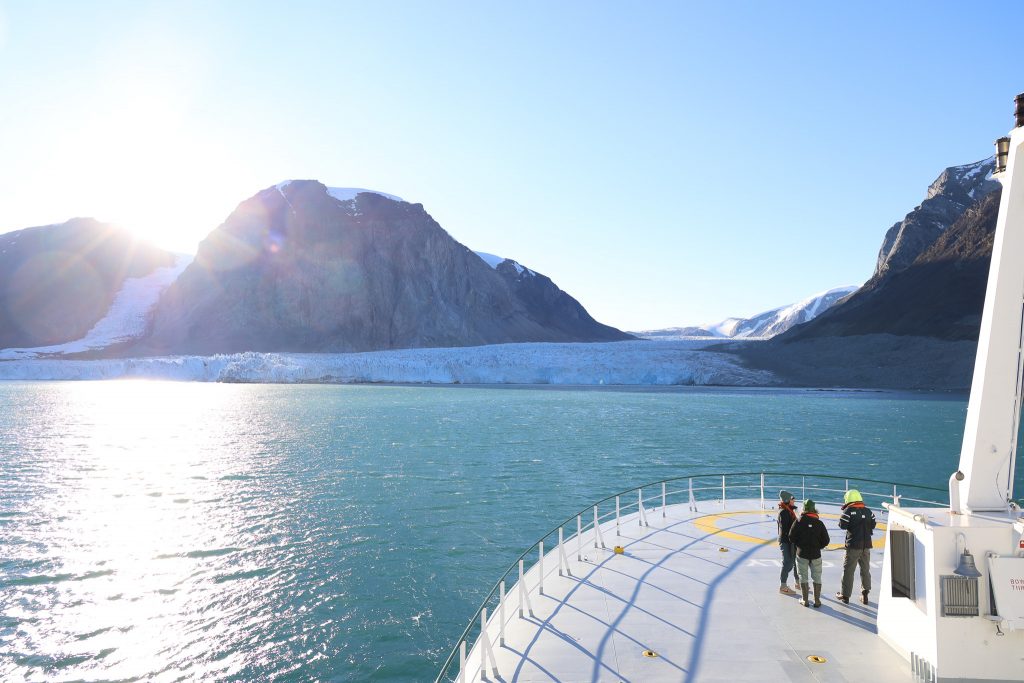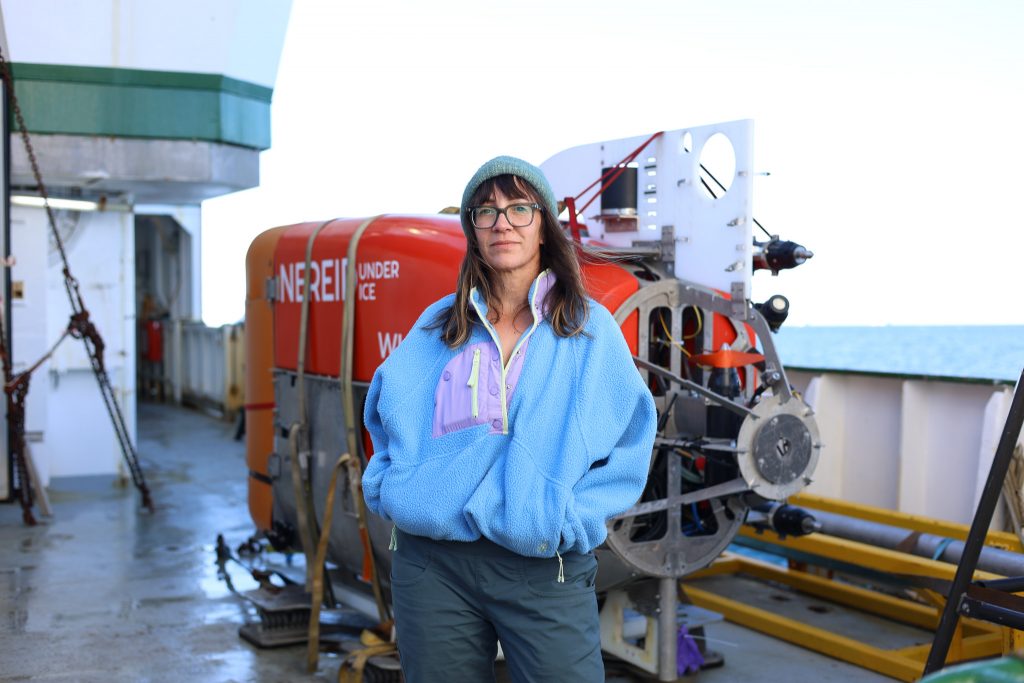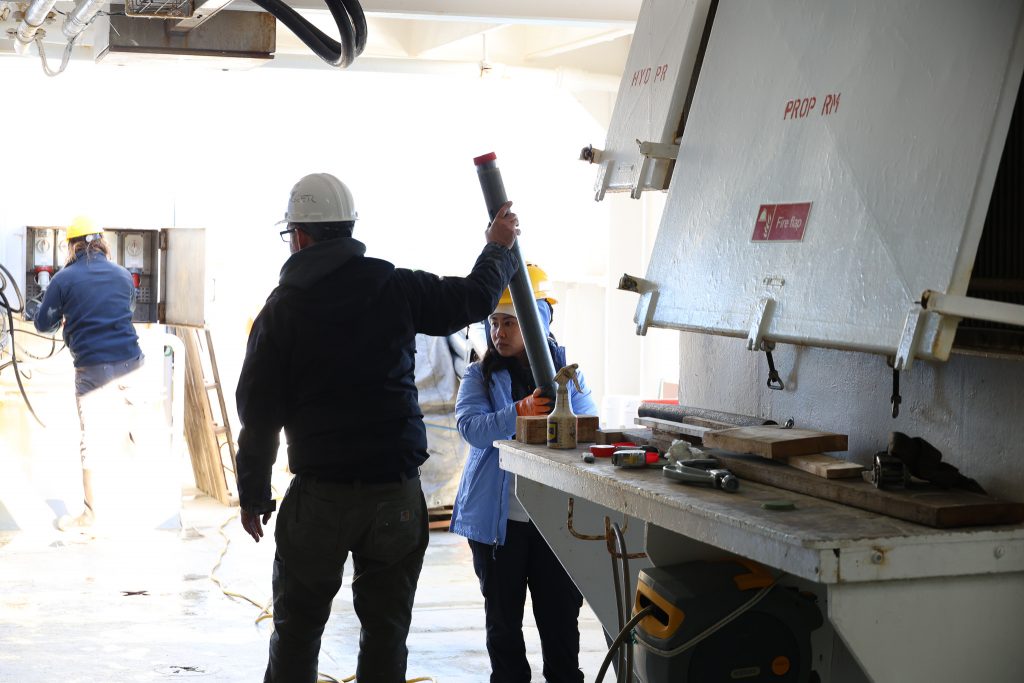

This is a dispatch from Constantino Panagopulos, a science writer at the Jackson School of Geosciences, who is documenting the TERMINUS mission to explore Greenland glaciers from underwater. The mission is led by Professor Ginny Catania and collaborators. Learn more about it here.
It’s morning in the fjords of West Greenland, where for four weeks a research expedition led by The University of Texas at Austin has been surveying and sampling glaciers.
Today is the last day of science operations. In a few hours the research vessel Celtic Explorer will travel up the fjord and on to Greenland’s capital Nuuk. The scientists will part ways and return to their home institutions.
But the science has only just begun. In among the terabytes of information and stacks of glacial sediment samples are possible clues to the ice sheet’s future.
It’s difficult to know at this stage which of those clues will be most valuable, said chief scientist Ginny Catania, a professor at UT Jackson School of Geosciences and the University of Texas Institute for Geophysics.

“We’ve never seen anything at the glacier terminus with this much resolution before,” she said. “The measurements that we got were just so novel that the analysis has to be novel and that requires rewriting a lot of the book on how we’ll do that.”
For now though, the scientists must focus on the job in hand.
The science deck is busy. At mid-starboard, deck crew are deploying an ocean measuring sensor to eke some last-minute science from our last hour in the fjord. Nearby, engineers with Nereid Under Ice (NUI) — the expedition’s centerpiece robot submersible — are busy packing up instruments and securing their gear for the voyage home.
On the other side of the deck, a bleary-eyed coring team are tagging and stacking sediment cores that they pulled from the seafloor overnight.

For NUI expedition leader Molly Curran, it’s a bittersweet day. NUI’s final dive was called off due to ice conditions, but the dives that did happen were all wildly successful. The submersible delivered astonishing images of the glacier’s underwater ice-face with its multibeam sonar, measured ocean currents inside a submerged glacial ice cavern, and retrieved pristine glacial sediments from the foot of the ice.
“There’s a lot happening at the glacier underneath the surface,” she said. “Giving scientists the tool to access that environment and seeing the excitement on their faces the first time we did that was just super rewarding. It’s why I love my job.”
Between heavy machinery and hard-hatted scientists, I run into co-chief scientist Sean Gulick who leads the subsurface imaging team. Gulick, a veteran of 34 major science expeditions at sea, tells me that this cruise has been an amazing success.
“The amount of data of all kinds that we collected is kind of epic,” he said. “The integration of the geophysics between what NUI collected and what the ship has collected is going to be amazing.”
The wind has whipped up little white caps on the fjord’s surface. Ahead of the Celtic Explorer, the glacier Kangerluarsuup Sermia is still in shadow. I’m looking out on the ice from the bridge.
Down on the bow, Catania is assisting UTIG glaciologist Benjamin Keisling on the drone’s last aerial survey of the glacier. The team’s two uncomplaining drones have surveyed nearly 1,000 miles of ice on this Greenland trip. That data will help link the mission’s other measurements and core samples with the changes happening in the glacier, Keisling said.
As the last drone lands on deck, the sun breaks over the buttressing mountain and sets the glacier alight. The scientists join me on the bridge where I’m watching the Celtic Explorer head for open seas. An armada of icebergs follows slowly in our wake.
For the first time in nearly a month, the weary scientists have time to simply enjoy the view.

The scientists came into this project with a hypothesis that glacial sediments are protecting some glaciers from retreating too fast. To test that, they crossed an undiscovered frontier where for now at least, they’ve found more questions than answers. Witnessing first-hand the effort that’s gone into getting there, from the scientists, engineers, crew and logistics support back home, it’s clear that historic science is taking place.
Being part of this journey has been an enormous privilege and honor. With temperatures back home in Texas hitting record highs, it’s also a timely reminder that these are issues with huge societal importance.
This isn’t the last of my reporting on the TERMINUS Greenland research: I’ll be writing an in-depth piece for the Jackson School magazine, the Newsletter. Look for that in the fall! And we’ll be following the team’s results as they emerge in the months and years to come. For now, from a rolling ship in the Labrador Sea, this is your field reporter signing off!
This is the final dispatch on the mission. To see the rest, visit the TERMINUS mission blog.
